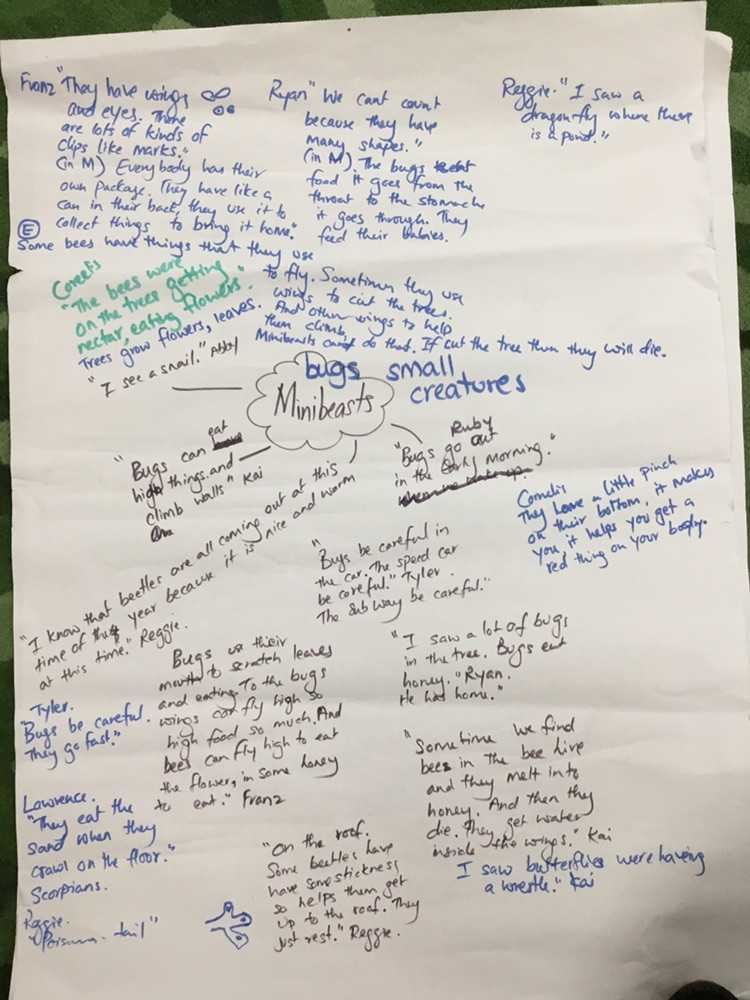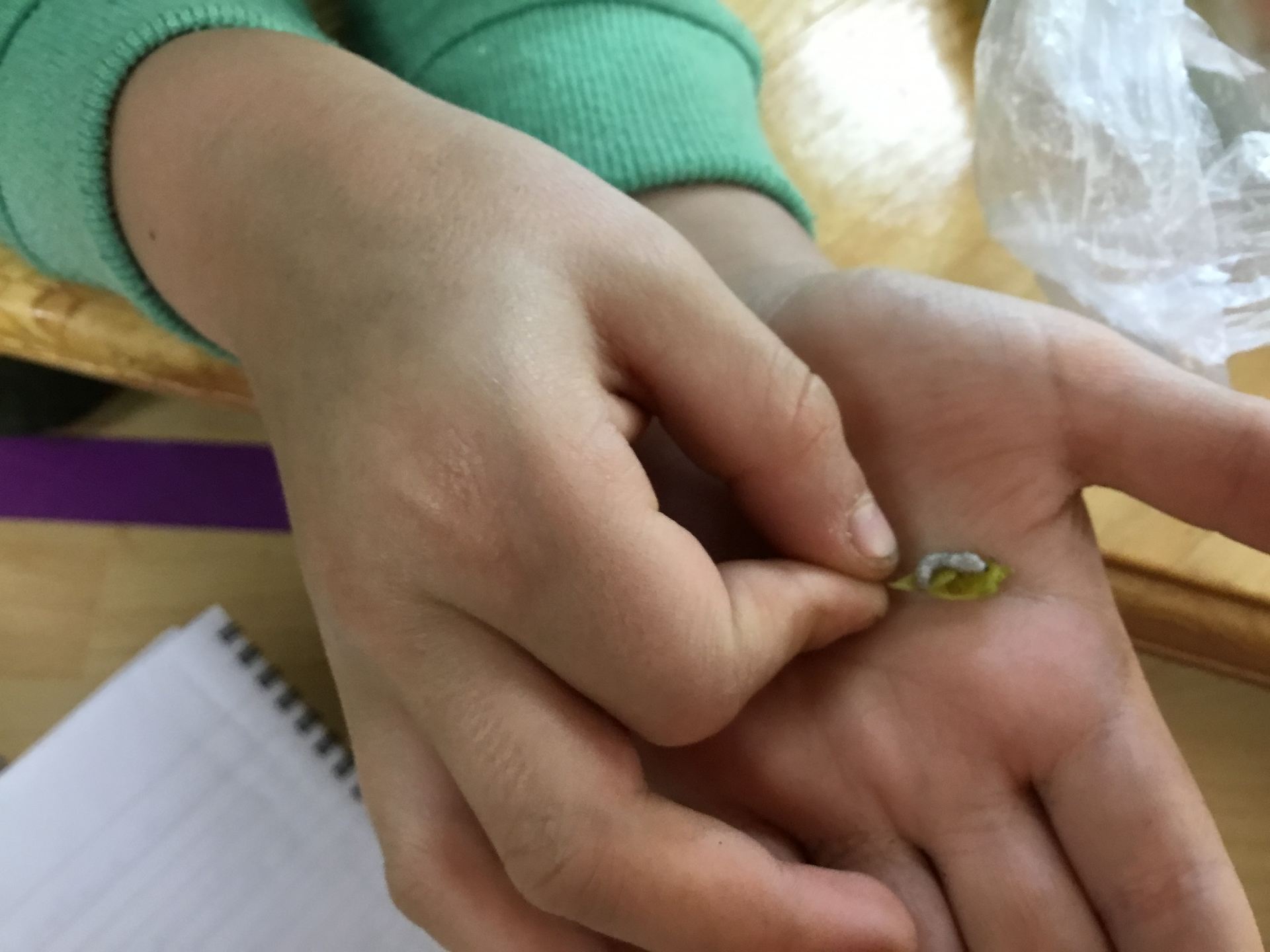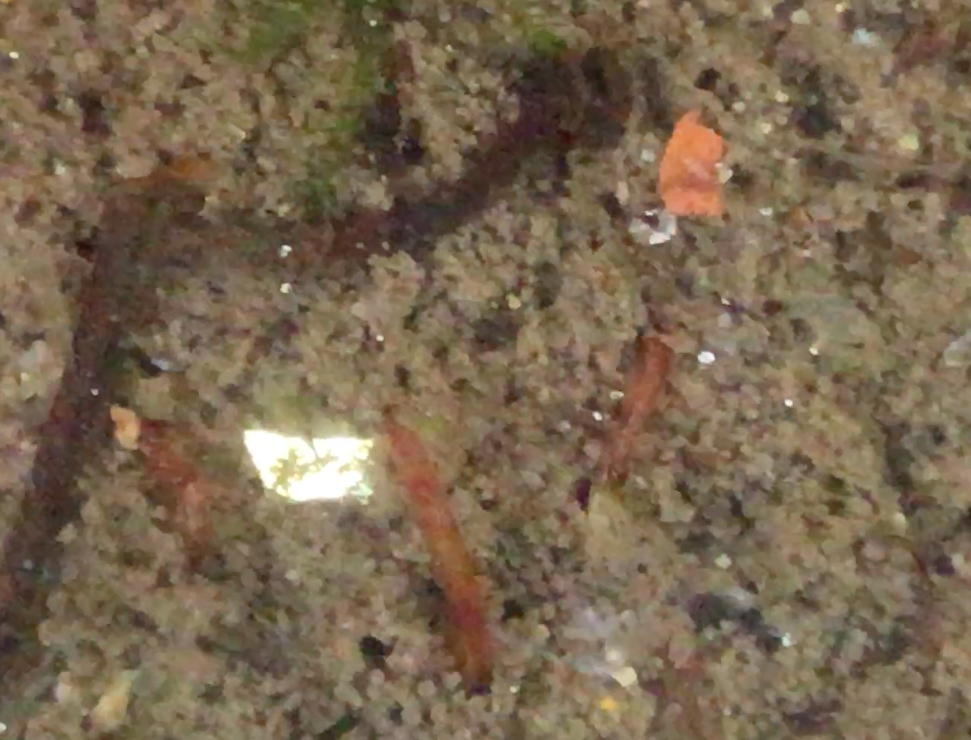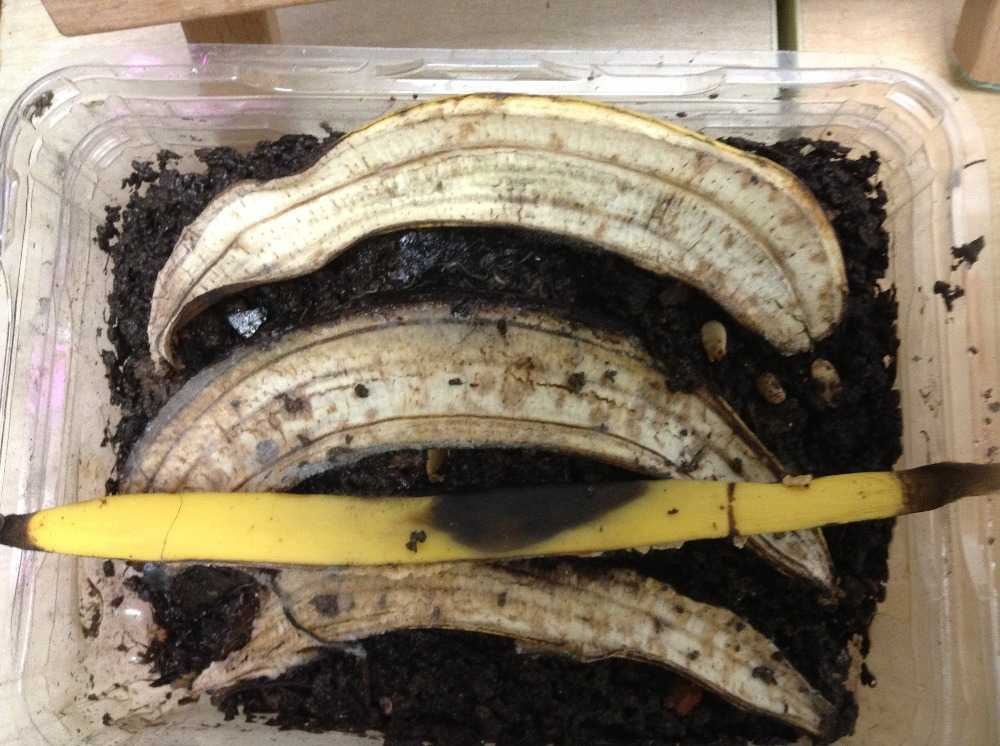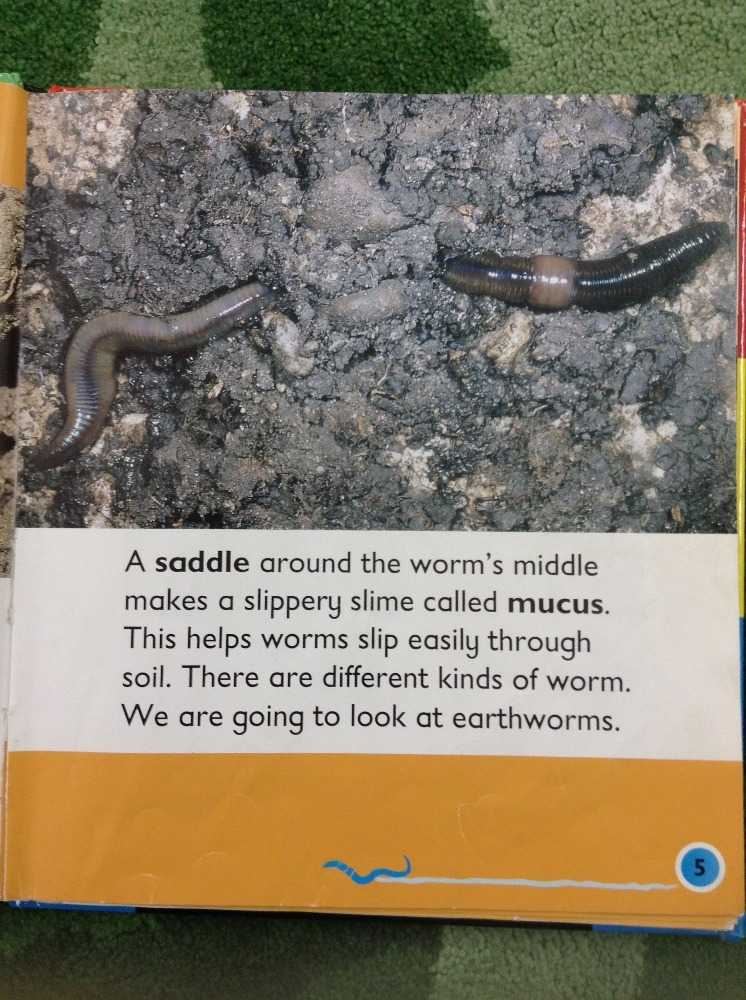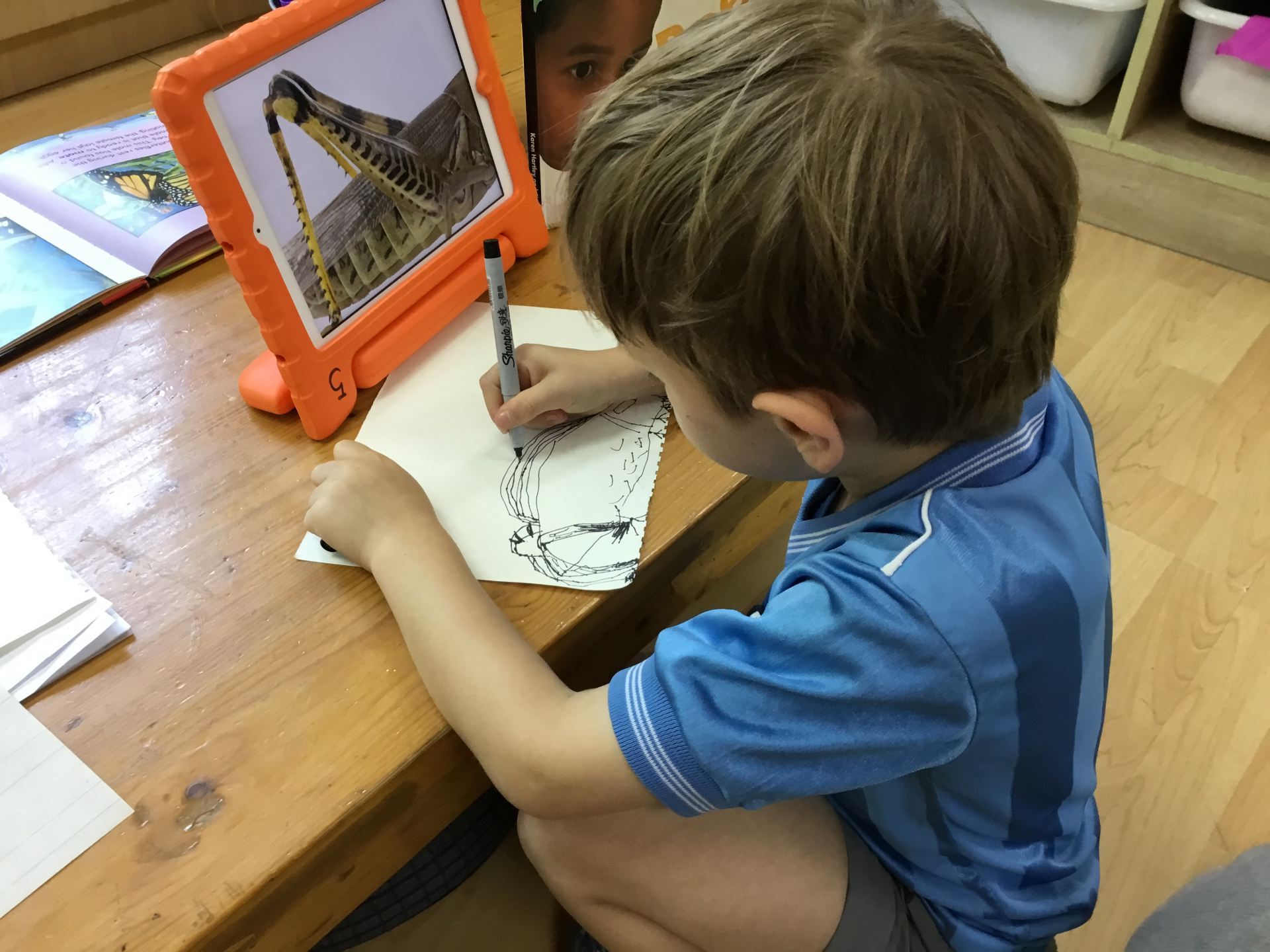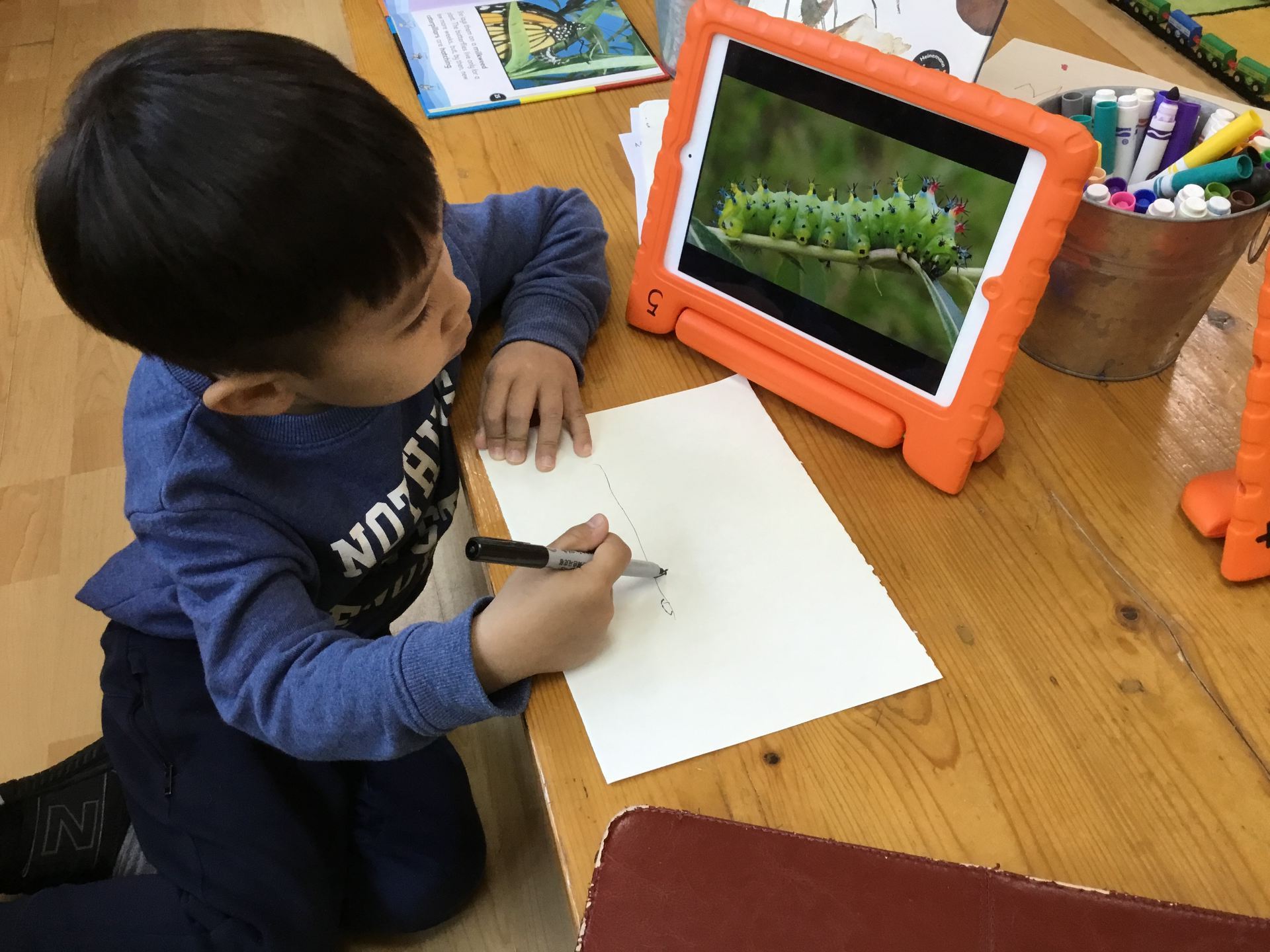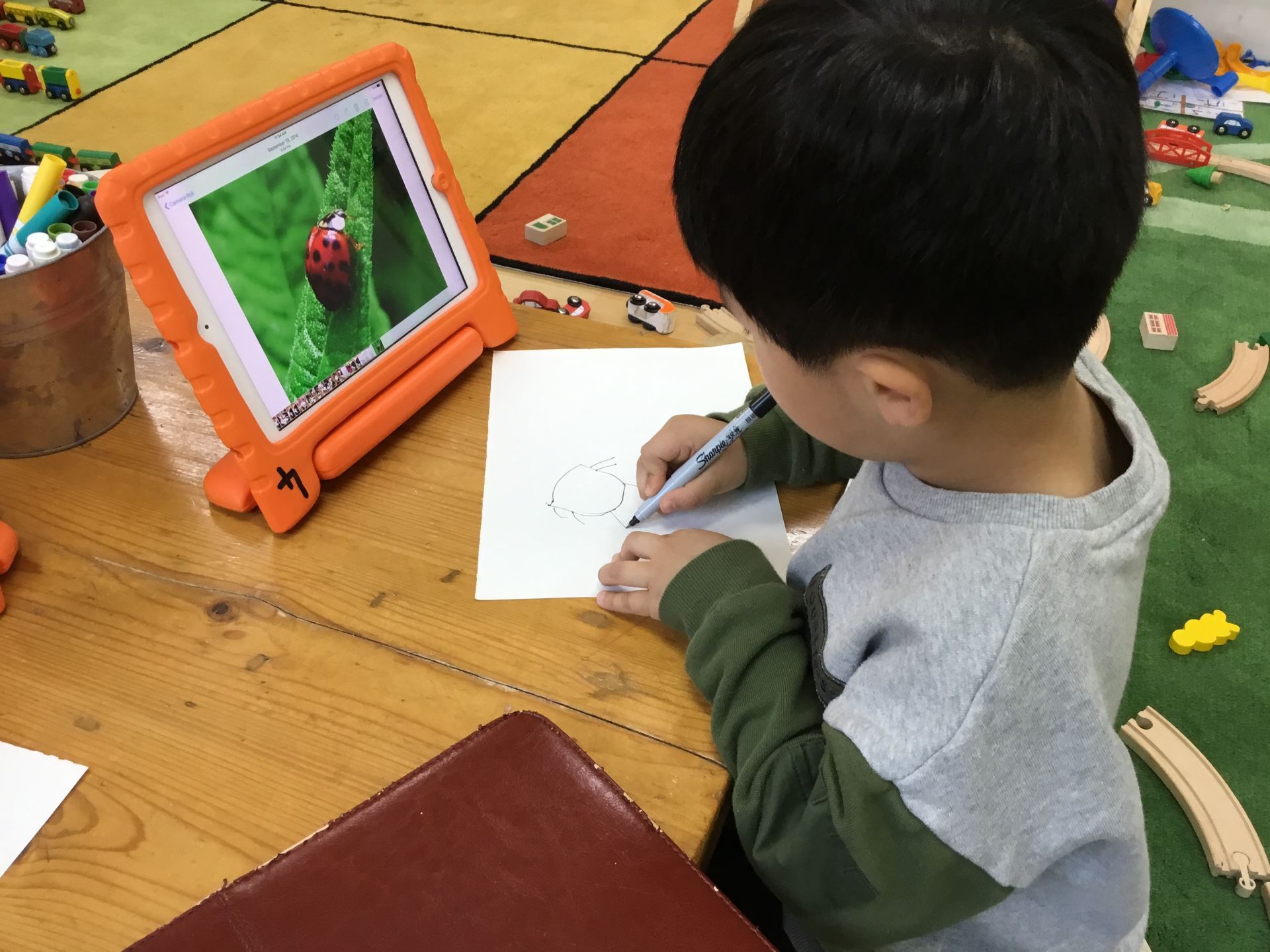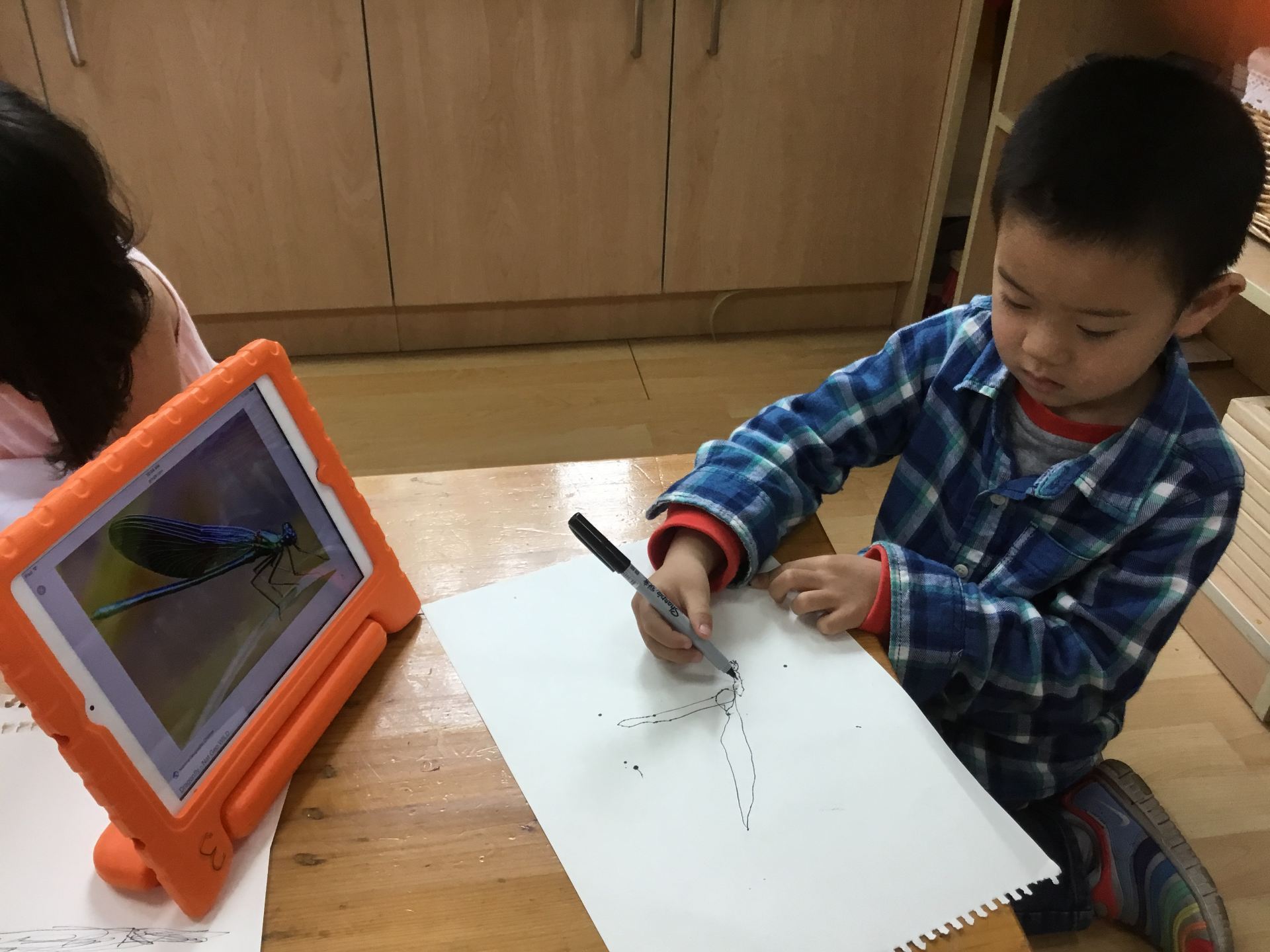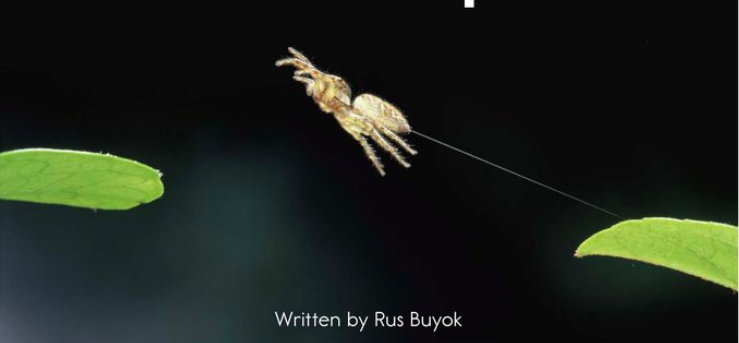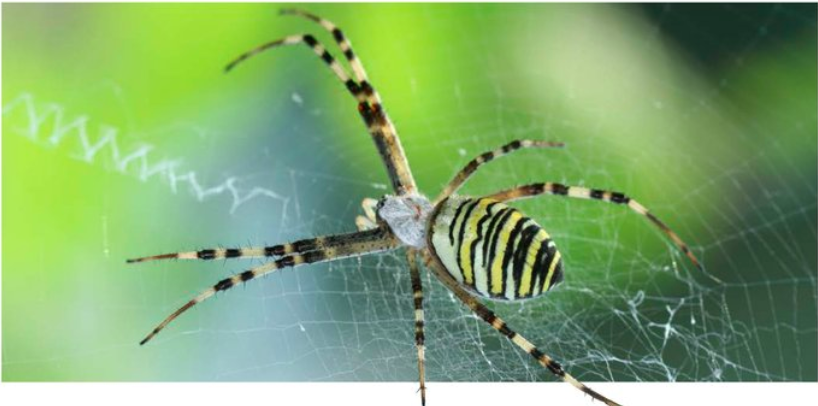Sharing the Planet
Minibeasts have certain requirements to survive.
Change, Connection, Responsibility
Related Concepts:
Conservation, Habitat, Growth, Classification
-
our needs and the needs of other animals, particularly minibeasts
-
our responsibility for the well being of animals (minibeasts)
-
how living things change as they grow
Story#1
The Worms
 Ruby had a banana peel. She wanted to throw it away. Ms. Hannah explained that worms like banana peels.
Ruby had a banana peel. She wanted to throw it away. Ms. Hannah explained that worms like banana peels.
Ms. Hannah brought in the worms.
- Reggie “Earth worms!”
- Ruby “Beach worms!”
We looked closer to see if we can see any worms in the tub.
- Franz “I see something! I see something!” [He points to the wet soil.
- Abby “I see very small ones.”
We looked again to see if there were any worms.
Next, we looked from the bottom of the tub. The students saw the worms, wriggling in the soil.
- Ruby “I can see the worms now. I can see a orange worm!”
The students decided that the worms don’t like to come out and be seen.
- Ms. Hannah “Why don’t they like to come out?”
- Kai “Because they like to live under ground.”
- Reggie “And birds might come and eat them.”
- Cornelis “They are really quick. Yeah! They are really quick to hide.”
- Ruby “And they just want to hide all the time.”
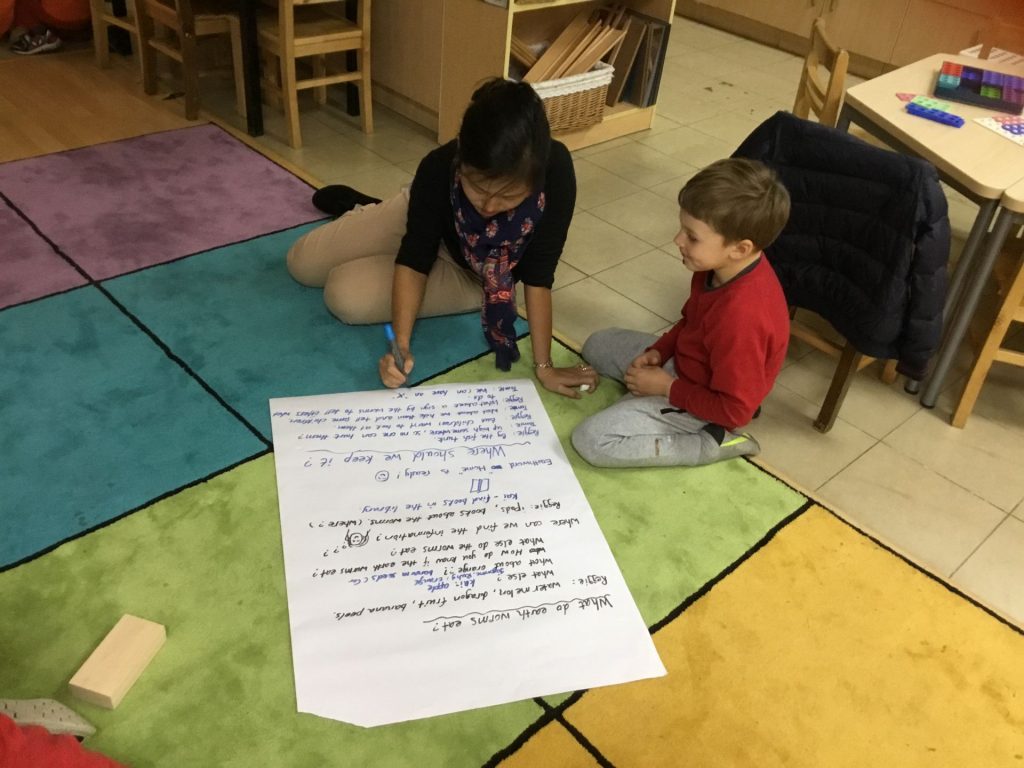
Reggie was wondering what they eat.
- Ruby “Banana peels!”
- Reggie “Watermelon and dragon fruit.”
- Kai “And apples.”
- Ruby “And oranges.”
- Cornelis “Maybe they eat watermelon.”
- Kai “Watermelon is too big.”
- Mia “The worm wants to go to the bottom because they want to eat food.”
- Cornelis “When they are really quick they want to have food, they hunt for food and then they hide because they always move to the places when they think that the people take their food.”
- Kai “They take it away into the holes. The holes are underground. The holes are where the worms live. Because they don’t’ want to be eaten.”
- Franz “Me and Ryan in another day, I see a worm and Ryan can’t see the worm. He is black a worm and he is so long. He is so big and so long. He wants to go to his home but his body is too big he can’t go into the hole. I used my shovel to dig but I can’t find the spot to dig. Then I looked in the sandpit and they don’t like the sand pit because the sand you [they] can’t eat it.”
- Reggie “We are making the worm house. So, we put soil on two different boxes and then we made a bottom box where the wee goes. So, when they wee and moving around they don’t have to touch any wee. The wee is liquid that worms don’t really like.”
- Reggie “We are putting the worms into a pot, then we put some watermelon in it for them to eat. And there is one really long worm that Alfred found.”
- Cornelis “When the black holes are a little shorter they look like a triangle but they look like a circle maybe, they just hide inside their holes when they are this long. 100. Is the biggest number.
- Reggie “The house is really like a hotel because there is a layer up and a layer down.”
 The students made signs for the display.
The students made signs for the display.
- Reggie “Me and Tomie are making signs so that people don’t touch the worms. If you touch the worms you might squeeze it and it might die.”
- Kai “Be gentle.”
- Reggie “If you want to touch the worms then you gently pick it up and put it on your hand. But if you gently squeeze it and pull it up it will be dead. We should look after them. We can give them baths. So, you give it like a plate and then you put like soap on it and put the water on and then it will get clean.”
- Cornelis “They really are quick when they hunt for food. They rush to get food and then they rush back home. They are really scared so they are really quick.”
- Mia “I am scared. Because he is moving.”
- Abby “They were very fast.”
- Reggie “They don’t’ sneak up on you and bite your fingers!”
- Tomie “The sign says don’t touch , only look.”

https://twitter.com/NISPreKK1/status/976423653540732928
SLO’s
- how to take care of things
- resources are necessary to meet the needs of living things
- the ability to take care of things – animate and inanimate
- appreciation of own environment and all living things in it
- a sense of wonder and curiosity
Story#2
The Brainstorm
What do you know about bugs?
We sat down together to talk about what we know about bugs, minibeasts and little creatures.
- Abby “I see a snail.”
- Kai “Bugs can eat high things. And climb walls.”
- Reggie “I know that beetles are all coming out at this time of the year because it is nice and warm at this time.”
- Franz “Bugs use their mouth to scratch leaves and eating. To the bugs wings can fly high, so high to food, so much [they can fly high to get their food]. And bees can fly high to eat the flower, in some honey to eat.”
- Reggie “O the roof, some beetles have some stickens [sticky feet] so it helps them to get up to the roof. They just rest.”
- Tyler “Bugs be careful in the car. The speed car be careful. The subway be careful [you need to be careful about the bug flying into the car when you are speeding on the highway].
- Ryan “I saw a lot of bugs in the tree. Bugs eat honey. He has a home.”
- Kai “Sometimes we find bees in the beehive and they melt into honey. And then they die. They get water inside their wings.”
- Ruby “Bugs go outside in the early morning.”
- Cornelis “The bees were on the trees getting nectar, eating flowers. Trees grow flowers, leaves.”
- Kai “I saw butterflies having a wrestle.”
- Tyler “Bugs be careful, they go fast.”
- Lawrence [in Mandarin] “They eat the sand when they crawl on the floor. Scorpions!”
- Reggie “They have a poisonous tail!”
- Franz “They have wings and eyes. There are lots of kinds clips, like marks [they have patterns and marks].” [in Mandarin] Everyone has their own package. They have like a can in their back, they use it to collect things to bring it home.”
- Ryan “We can’t count because they have many shapes.” [in Mandarin] The bugs eat food, it goes from their throat to their stomach, it goes through. They feed their babies.”
- Franz “Some bees have things that they use to fly. Sometimes they use wings to fly. Sometimes they use wings to cut the trees. And other wings to help them climb. Minibeasts can’t do that. If you cut the tree then they will die.”
- Cornelis “They have a little pinch [stinger] on their bottom, it makes you get a red thing on your body.”
- Reggie “I saw a dragonfly where there is a pond.”
The conversations were about snails, bees, scorpions and dragonflies.
The main concepts shard by students were about:
- food
- they eat – nectar,
- transport food
- feed their offspring
- provide food for humans – honey
- movement
- fly
- climb walls
- crawl
- homes
- ponds
- beehive
- characteristics
- eyes
- tails
- wings
- suckers at the end of feet
- digestive system
- adaptations
- poisons
- sharp teeth
- patterns
- to transport food
- lifestyle due to
- climate and weather changes
- day and night
- seasons
- behaviours
- fighting among species
- safety
- while traveling
- bites and stings
We will use the brainstorm to plan some of the experiences that will help us learn more about the creatures we share the planet with.
Story#3
Bug Hunt!
A group of students went on a hunt. They were looking for bugs.
- Helena “Look here are some ants.”
- Tomie “Ants are bugs too.”
- Reggie “These ones are green Aphids.”
- Tomie “They suck your blood.”
- Reggie “And ladybirds eat them.”
- Reggie “Woodlouse and earthworms live under this rock. There’s a baby earthworm.”
- Helena “I can see a butterfly and that’s a bee.”
- Tomie “No, it’s a wasp, a big wasp.”
- Reggie “Let’s go I don’t want to be stung again.”
- Teacher “What is this creature?”
- Tomie “I think it’s a beetle.”
- Reggie “Is it dead?”
- Teacher “I think it’s pretending to be dead.”
- Tomie “Why?”
- Reggie “So that we can leave it alone.”
- Tomie “Yes, some beetles do that.”
We wonder about the littles creatures that live around us…
Story#4
The Silkworms
A group of students were observing the silkworms. They have been taking care of the worms and watching their growth.
- Cornelis “They are growing. They are getting longer and longer and stretching.”
- Kai “They are getting longer and longer.”
- Franz “They are all the trees. If the silkworms eat all the tree leaves, then the tree like a ghost tree.”
- Reggie “It’s a tree with no leaves.”
- Reggie “There is a lot of poo in there. They got bigger. There is also a place for the poo and dried up leaves, and when it fills up we empty it into the bin.
- Reggie “They are kind of lazy. Because they eat up to 2 leaves a day, because they are so hungry.”
- Cornelis “If all the silkworms go on the branch, the bottom branch will break then there will be no more trees. If you put too many leaves with water the silkworm will die. They don’t like wet leaves.”
- Reggie “You need to wash them and dry them and then give it to them.”
- Ryan “Silkworms not like water.”
- Amber [in Mandarin] “The silk worms came from the eggs.”
- Reggie “I just saw a little bit of silk on mine.”
- Cornelis “It means that is it going to climb on the trees. That guy is on top of the other! The long one is in the very private parts of the other! Look at all that POO!”
https://twitter.com/NISPreKK1/status/1009319652181225472
SLO’s
- how to take care of things
- appreciation of own environment and all living things in it
- a sense of wonder and curiosity
- enthusiasm and respect for nature and Earth
Story#5
Bug Walk
- Teacher “What have you found?”
- Cornelis “We found the water worms.”
- Kai “They look like worms.”
- Cornelis “There are so many of them.”
- Abby “I can see some too.”
- Teacher “Why are they wriggling?”
- Reggie “Because they like to move.”
- Cornelis “I think they are swimming.”
- Reggie “Here are the red wriggly things.”


- Cornelis “Look what we found.”
- Abby “I see a snail. I see a snail shell.”
- Teacher “Where is the snail?”
- Abby “It went out, it’s eating a leaf.”
- Cornelis “No the snail is hiding inside the shell.”

- Teacher “Why are there so many holes in these leaves?”
- Cornelis “That caterpillars came and ate them.”
- Kai “This is a beetle.”
- Abby “There are lots of them under the rock.”
- Cornelis “It’s their home.”
- Abby “They like to live under there (points to the ground).”
Cornelis “There are so many here, they are going deeper underground.”
https://twitter.com/NISPreKK1/status/984294902379917313
SLO’s
- how to take care of things
- appreciation of own environment and all living things in it
- a sense of wonder and curiosity
- enthusiasm and respect for nature and Earth
Story#6
Worms
We have been looking after our worms in the classroom worm farm. We have many questions about the worms. We have also collected a lot of worm pee, which is very good for the soil. After some weeks, we have many baby worms in our worm farm. We read a book about ‘worms’ to find out more.
- Abby “They are so slimy!”
- Reggie “Because the soil is wet, that’s what makes them slimy.”
- Cornelis “It was in my garden, they slide around.”
- Teacher “What other animals slide around?
- Ryan “Snakes!”
- Tyler “Silkworms.”
We read on…
- Kai “I found a little worm in my kitchen.”
- Franz “The earthworm is in the sand. Too deep. We can’t dig it.”
- Ryan “They live under the ground.”
- Kai “It’s really slippery.”
- Mia “When we found it, we don’t stamp on it.”
- Cornelis “It looks like a cocoon.”
- Kai “The yellow one is like a cocoon.
- Ryan “I saw a black part.”
We wondered what animals eat worms, birds, moles…
Reggie showed the others how the mole eats worms.
Story#7
Minibeasts – Observational Drawings
The students have been reading books, observing minibeasts, and sharing their ideas about how these creatures live and grow. We have enjoyed wandering through the garden and vegetable plots at school, observing the many little creatures that live around us. These experiences have encouraged us to appreciate and respect our own environment and all living things in it.
https://twitter.com/NISPreKK1/status/987560128504217600
Over the last few weeks, we have been caring for silkworms in the classroom. Each day we need to move the baby silkworms on to fresh leaves, and clean out the dry ones. We also need to make sure the class ‘worm farm’ has a fresh stock of food. During these daily tasks, we explore the resources that are necessary to meet the needs of living things.
The students have engaged in conversations about the impact of our actions on the immediate environment. Some discussions have also included funny or scary personal stories about these little creatures.
The students were invited to observe and draw pictures of their favourite minibeasts. Noticing details, discussing ideas and observations have been a vital part of capturing these as images on paper.
- ‘Snails’ “When it is a rainy day, he comes. Sometimes they come, sometimes they are cold. They like worms. Sometimes they are so cold they hide in their shells. They eat some leaves. But sometimes the caterpillar is scared of them, because they are so big. Outside the trees are growing, they are so cold. They don’t want to be cold and they go under ground or under leaves. They always don’t come when it is sunny or snowy. Because it is so hot or too cold. They just like rainy. The little ones does not like snow. They just sleep when it is morning because it is so tired.”
- ‘Scorpion’ “Scorpion has a lot of legs and claws. Scorpion like has a tail. And scorpion has 4 claws and he hitting someone and second claws he is eating. And have two eyes. There have two sets for hitting on his tail.”
- ‘Ladybugs’ “That is a ladybug that he is on his house then he have outside play and he baby is sleeping again. Then he will wake up. But then baby wake up there is a fire in the ladybug house. Then have to firefly. Then firefly fly in ladybug houses and put water on the fire and then the fire almost gone. Ladybugs likes to eat, I think leaves. I like ladybugs because they have 4 wings.”
- ‘Butterfly’ “When a caterpillar and it turns to a butterfly. I seen some butterflies on the playground. I like butterflies and they are so beautiful some are grey, but I like rainbow butterflies.”
- ‘Grasshopper’ “Grasshoppers jump, it feels like, if it was a person, it would be like jumping over a building. One day in my cousins garden I saw grasshoppers jumping. I think I saw my brother and my cousin put them on their hands and they were jumping. They can jump really high. I see wings at the back of it. I think their wings also help them to jump. I wonder what they eat and how they jump.”
- ‘Caterpillar’ “He just want to find the house and eat the food. I think he likes to eat the snakes. They live in a tree. Because he wants to climb up a tree and eat the food. This is a leaf. He grow and grow bigger and bigger and he can make like a butterfly.”
- ‘Caterpillar’ [in Korean] “I drew a caterpillar. I wrote my name in English. Originally, I drew circles then I drew sticks. The sticks are like thorns, like spiky stuff. My caterpillar looks different from other caterpillars.”
- ‘Dragonfly’ “Dragonflies eat petals from flowers and eat nectar like bees. They have patterns on their wings. The wings have brown lines around. I like them because I have a toy dragon fly at home and I can’t use it anymore, and we have to throw it and it is broken. The broken dragonfly is like a rainbow. Dragonflies are afraid of swords. They build their homes to get nectar. So, they put it inside their homes. They have a beehive, but it is different to the bee’s ones. They like to live on the ground. They dig underground with their pointy tails. Dragonflies can cut paper with their wings because they are very sharp. I have seen a dragonfly flying around in my house.”
- ‘Ants’ “Ants, some ants mouth like that, like sharp teeth and some ants don’t have like that. Because this ant is make houses. Because he is looking for some ants house, and she say go away. He eats some ants. Because some ants don’t have like that. Some babies are going to find ants. (explaining how some ants may eat other ant babies) I put some candies in ants house, he can help them to find food. This is a watermelon. Because my drawing teacher said some ants, winter is so cold, and they like to stay home. When the winter is coming, the ants take so many water melon and some ants are not here because it is so cold. And ants mummy is too cold, she don’t want to find watermelon, some food, because she need to help the babies coming big. [in Mandarin] Some ants are fed by mummy ants. There are like working ants, they always work for the mummy ants. If the working ants are being lazy the mummy ants will eat the others.
- ‘Ladybug’ [in Korean] “I drew a ladybug. I don’t know why I drew it like that. The bottom thing is the leaf. This is the leaf, it is the thing that the ladybug eats. There are dots on it. I don’t know what the dots are. The dots on the side are the ladybugs poop.”
- ‘Caterpillar, swimming worm, snail, butterfly, tree’ “The caterpillar lives on a tree. He lives in a cocoon on a tree. When the cocoon changes, then he was inside an egg and then he hatched into a silkworm. And then went into a cocoon and then he changed into a butterfly. It is really cool. They eat the leaves. I also saw some snails. They were slithering around in my house, they were also in my garden. I wanted to make a trap because I was trying to make a leaf. But then it slithered around over. There were swimming worms in the water.”
- ‘Hornets’ “One day I saw one, actually two. We first thought it was a bee when we were on the bug hunt, then we thought it was a wasp and then it was not. The wasps are more pointy at the back. It is very, it is like a cylinder. When you get close up it gets sharper and sharper. If anyone tries to destroy where they live or hurt them, they can give them payback. The hornet is longer than the wasp. I don’t like them because they have a stinger and it hurts more. I don’t really know how much it hurts because I have not been stung.”
- ‘Grasshopper’ “He can spring over the grass. He don’t know to walk like I. He eats grass when he is springing to the grass. He is go to the flowers from the grass, to get the bees to give the butterfly. Then they bring it to the house. He no fall down when he has this (spines on his legs).”
- ‘Grasshopper’ (In Japanese) “They eat grass. They can jump. They have six legs. Grasshoppers eat grass.”
- ‘Mosquito’ “I like the mosquito because I like to touch it. Mosquitoes sting on people. They are looking for food to eat. They live in the hole.”
- ‘Dragonfly’ (In Mandarin) “The dragonfly lives in the pond of the garden. They eat flies and mosquitoes.”
- ‘Dragonfly’ “The dragonfly has tails. They fly all day long. They fly around everywhere. They used to do the loops, they fly up and down. They eat strawberries.”
- ‘Dragonfly’ (In Mandarin) “My dragonfly looks like a sausage. The wings look like the propeller of the helicopter. It is eating the mosquito.”
- ‘Dragonfly’ (In Mandarin) The head of the dragonfly looks like the head of the frog. They fly around, because they are looking for the little bugs such as flies and mosquitoes.”
- ‘Dragonfly’ (In Mandarin) “My dragonfly has two wings and a leg body.”
- ‘Centipede’ “我知道这是蜈蚣,因为我看过蜈蚣。这些是它的脚,它有100只脚。糟了,我还没有时间给它画嘴巴。它有一个大大的嘴巴,这个是它后面的屁股。如果你去碰它,它会来咬你。我不要去喷它,它会马上来吧我毒死。这是妈妈跟我说的,但是我今天回家要跟妈妈确认一下。” I know this is a centipede because I saw a centipede before. There are its feet. It has 100 feet. Oops, I haven’t had time to draw its mouth. It has a big mouth, and this is its bottom. If you touch it, it will bite you. I don’t want to touch it, it will poison me right away. My mom told me that, but I have to check with my mom when I go home today.”
SLO’s
- develop an inquiring mind
- ask simple questions
- make observations about their immediate environment
- make statements that reflect their understandings
- listen to others
- interpret and analyse visuals and multimedia to gain understanding
- draw simple drawings to express what they see/study
- sort and classify objects into categories by attributes (Similarities & Differences)
- communicate views and knowledge about people, places and their immediate environment in different mediums
Story#8
Worms “Where do they want to live?”
We have been taking care of the worms in the class worm farm for a while. We had to decide what our next step was. Ms. Hannah helped the students recall what they know about worms.
- Teacher “Where do they really like to live?”
- Reggie “Some of the baby worms fall in the pee.”
We wondered if that is where the worms wanted to be. They had fallen through the littles holes at the bottom, into the worm pee, which we were collecting to add to the plants.
- Teacher “Where’s the better home for earthworm to live?”
- Ryan 我在地上看到一些小蚯蚓,它头伸了出来。我很小心,没把它压死。
- Teacher “Do you mean they live underground?”
- Mia “They live in the sandpit.”
- Ruby “I saw one live in the sandpit at home.”
We wondered if we could take a closer look at the worms. We recalled what to book said about the worms.
- Ryan “NO, 要用放大镜”
- Teacher “Yes, a magnifying glass.”
We went read the book again. It says, “The earthworm spends most of time underground!”
- Reggie tapped the floor “It’s here.”
- Cornelis “The earthworm lives in the brown like garden.”
- Ruby “They go inside the wood. (pointing to the floor), when it closed, it will be chopped.”
We discussed if worms wiggled on the wooden flooring. Where can we put them?
The students compared earthworms and the silkworms. They eat different things and live in different places.
- Teacher “This is the cocoon.”
- Ruby “Butterfly”
- Teacher “Do they turn to butterfly?”
- Lawrence “Ms. Hannah,那个yellow big.”
- Teacher “Why do they live underground?
Some of the students said, that they want to be away from the other animals who will eat them. The continued to look through the book.
The students then decided to move the earth worms into the class garden plot. We marked a spot. The students watched as the worms wriggled back into the wet earth.
SLO’s
- how to take care of things
- appreciation of own environment and all living things in it
- a sense of wonder and curiosity
- enthusiasm and respect for nature and Earth
Story#9
We Are the Ladybugs!
The students have been preparing for their ‘Early Years Arts Showcase’. We have been practicing the songs, working on the choreography, and deciding what the costumes may look like.
Fist we wanted to know more about ladybugs. We found some ladybugs during our walk to the garden plots!
 We read some books about ladybugs to learn more about them. We like the story of the ‘Grouchy Ladybug’ by Eric Carle. This is a story about a grouchy, bad-tempered bug who won’t say “please” or “thank you,” won’t share, and thinks she is bigger and better than anyone else. The story focuses on the benefits of friendship and good manners. We followed the Grouchy Ladybug on her journey, which also included concepts of time, size, and shape.
We read some books about ladybugs to learn more about them. We like the story of the ‘Grouchy Ladybug’ by Eric Carle. This is a story about a grouchy, bad-tempered bug who won’t say “please” or “thank you,” won’t share, and thinks she is bigger and better than anyone else. The story focuses on the benefits of friendship and good manners. We followed the Grouchy Ladybug on her journey, which also included concepts of time, size, and shape.
While reading through some of the non-fiction books, we found out that some ladybugs have white spots!
Next, we needed to plan how to create our costumes for the showcase. We decided that we could have red, yellow and orange costumes.
SLO’s
- engage with, and enjoy a variety of visual arts experiences
- select tools, materials and processes for specific purposes
- use their imagination and experiences to inform their art making
- use their imagination and original ideas to write and create music, dance and drama pieces to express feelings and moods
- participate in performing and creating performing arts pieces both individually and collectively
- create roles in response to music using instruments, props, sets and costume
- explore basic bodily movements and the use of space
- create artwork in response to a range of stimuli
Story#10
All About Spiders
We read the book ‘All About Spiders’ on Reading A-Z. We shared what we know, see and wonder about the non-fiction book.
- Abby “The spider is making a web.”
- Kai “It’s got silk coming out of its body.”
- Reggie “It’s got silk coming out of its bottom!”
- Ryan “It’s not silk. That is like a bridge. He wants to go to another way. He go that way and then spider web.”
- Ruby “That IS.”
- Cornelis “The web is on the bottom. There is lots of webs in this book. When he sticks it out he goes back and forward. When he gets tired, he sleeps on his web.”
- Tyler “This spider is scary.”
- Hannah “Because that leg is like a tiger. The middle one.”
- Kai “It has a mask, like to scare predators away.”
- Vincent “The one in the middle has spikes.”
- Cornelis “Maybe when you touch his spikes you will get ouchy.”
- Abby “It is very pointy.”
- Ruby “When you touch its spikes it hurts.”
- Reggie “The spider in the middle, he is pretending he is a flower. So the flies will just move there.”
- Vincent “Camouflaged!”
- Hannah “I found a spider web outside. I touched it with my feet.”

- Ryan “So beautiful.”
- Abby “I love the colour.”
- Hannah “Why is the spider holding the bee?”
- Ryan “The spider wants to hold the bee. He wants to go to his home.”
- Reggie “That bee was hidden in a flower, so the spider grabbed it and went to eat it.”
- Hannah “Why are spider legs like scissors?”
- Kai “Because, then the silk comes out it will get stuck to the grass and the spider will hang on to it.”
- Reggie “The silkworm also makes silk!”
- Cornelis “They stick it on their bodies.”
- Reggie “The spider’s silk comes from the back and the silkworms silk comes from the mouth.”
- Hannah “Why spiders have a spider web?”
- Franz “Because fly bugs fly to the spider web. The spider catches it and then eats it.”
- Ryan “He touch spider web, it is sticky.”
- Vincent “If he makes the spider web, that is his home. The fly doesn’t see it. They fly into it and then he eats it.”
- Hannah “Vincent say it right but I think it is also a way to fly [helps them move from one place to another].”
- Cornelis “If they don’t see a web and the fly gets it, the spider traps the minibeasts in their web. He spins him up and gets stuck in the web. There he will get dead and he will eat him.”
- Hannah “Why do spiders look like a monkey?”
- Kai “That hair is like a gorilla!”
- Reggie “Some spiders can have up to 20 eyes!”

- Vincent “In the spider nest.”
- Reggie “The eggs are the same colour as the mummy.”
SLO’s
- participate and respond actively to read aloud situations; make predictions, anticipate possible outcomes
- make connections to their own experience when listening to or reading texts
- listen and respond to picture books, showing pleasure, and demonstrating their understanding through gestures, expression and/or words
- observe, discuss and comment on the information being conveyed in illustrations
Story#11
The Nature Walk
A group of students went on a ‘Bug Hunt’. They took a closer look to see what mini creatures they can find.
- Amber “I found ants, they are moving the rice.”
The students went towards the bamboo forest, the field and the playground.
- Jasmine “Butterfly! It’s white.”
- Amber (Pointing to the wall) “Caterpillar.”
We noticed that it has many legs.
- Jasmine “It’s centipede.”
- Lawrence “I see snails.”
- Michelle “There’s more….”
- Amber “There’s a big one above the wall.”
The students counted to see how many snails were around.
- Jasmine “So many butterflies.”
- Amber “Why are there many butterflies?”
We didn’t see many butterflies when we had a hunt a couple of days ago. Now we can see many of them flying around the field. It is interesting. We also wonder why the butterflies all came around the garden.
- Lawrence “I found bees.”
What little creatures do you see around you?
Our Grade 2 buddies came to help us gather some data on the different minibeasts we have in our garden. They helped us record our information using tally marks.
https://twitter.com/NISPreKK1/status/1003916047575990272
SLO’s
- collect information to make sense of the world around us
- record observations using simple tally marks (1 line/1 object)
- explain data using simple language such as same and different/more or less/most or least




